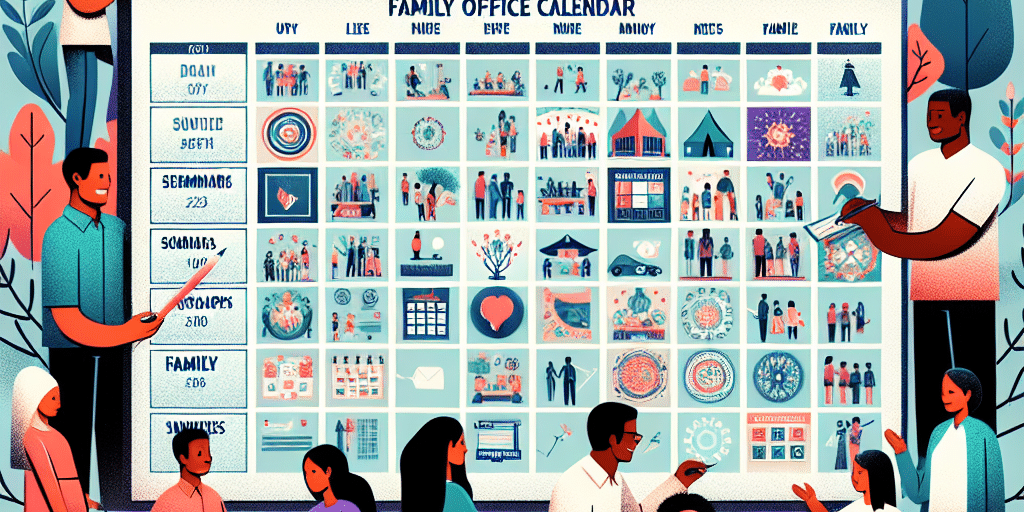Creating a robust event calendar for a family office is essential to foster community, promote engagement, and ensure alignment with family values and objectives. A well-structured calendar not only keeps family members informed but also helps in developing meaningful connections and managing investments effectively. Here’s a step-by-step guide to crafting the perfect family office event calendar.
Step 1: Define Your Objectives
Before diving into the specifics, it’s crucial to outline the goals of your event calendar. Consider the following:
- Networking Opportunities: Do you want to connect with other family offices, advisors, or investment opportunities?
- Education: Will the events focus on financial literacy, estate planning, or philanthropy?
- Family Bonding: How important are social or recreational events to strengthen family ties?
- Thematic Focus: Are there specific values or themes that the events should reflect, such as sustainability or innovation?
Action Item:
Create a list of objectives to guide your calendar planning.
Step 2: Identify Key Stakeholders
In a family office, it’s critical to consider the diverse interests and needs of various family members across generations. This includes:
- Family Members: Engage all branches of the family, from younger generations to elders.
- Advisors and Experts: Incorporate input from financial advisors, legal counsel, and philanthropy experts.
- Community Connections: Include external partners, like nonprofits or business contacts, who may be relevant to the family’s interests.
Action Item:
Conduct informal interviews or surveys with stakeholders to gather their insights and preferences.
Step 3: Choose Event Types
Diverse event types can cater to various interests and objectives. Here are some suggestions:
- Educational Seminars: Focus on financial literacy, investment opportunities, or legal updates.
- Networking Dinners: Host informal gatherings with other family offices or trusted advisors to share experiences and strategies.
- Family Retreats: Plan extended events that offer both recreational activities and opportunities for serious discussion.
- Volunteer Days: Encourage family members to engage with the community through service-oriented activities.
- Annual Meetings: Schedule a formal event to discuss family goals, financial performance, and strategic initiatives.
Action Item:
Brainstorm a list of potential event types and categorize them based on your earlier-defined objectives.
Step 4: Develop a Timeline
Creating a timeline helps in planning throughout the year and ensures that events complement each other. Consider the following:
- Seasonality: Some events may work better at specific times of the year (e.g., holiday gatherings, summer retreats).
- Frequency: Decide how often to hold events—monthly, quarterly, or annually.
- Family Events: Ensure that major family milestones (weddings, anniversaries) are accounted for to avoid scheduling conflicts.
Action Item:
Draft a tentative timeline for events throughout the year, identifying key time slots for different types of gatherings.
Step 5: Select Locations
The venue can significantly influence the event experience. Consider:
- Family Homes: Using private residences can create an intimate atmosphere for family gatherings.
- Professional Venues: For larger events, consider conference centers or private dining rooms that can accommodate your group comfortably.
- Outdoor Settings: Parks, nature reserves, or resorts may be suitable for retreats or informal get-togethers.
- Virtual Options: In today’s digital age, don’t forget the possibility of virtual meetings or webinars, especially useful for family members who are geographically dispersed.
Action Item:
Research potential venues and verify their availability and suitability for the planned events.
Step 6: Communicate and Share
Once your calendar is filled with events, communication is key. Utilize the following strategies:
- Digital Calendars: Use shared digital calendars so family members can see event details, RSVP, and receive reminders.
- Regular Updates: Send out newsletters or emails with upcoming events and highlights from past gatherings.
- Feedback Mechanism: After each event, solicit feedback to continuously refine the calendar and make improvements.
Action Item:
Develop a communication plan that includes timelines and channels, ensuring everyone stays informed and engaged.
Step 7: Evaluate and Adjust
At the end of each year or event cycle, take time to review the calendar’s effectiveness. Look at:
- Attendance Rates: Which events drew the most interest?
- Family Feedback: What did family members enjoy or dislike?
- Alignment with Goals: Did the events achieve the objectives set at the beginning?
Based on this evaluation, make necessary adjustments for the next planning cycle.
Action Item:
Schedule a family review session to discuss the previous year’s calendar outcomes and brainstorm improvements for the future.
Conclusion
Creating a family office event calendar is a dynamic process that requires thoughtful planning and consistent engagement. By following these steps, family offices can foster stronger relationships, promote educational opportunities, and align their collective efforts towards shared goals. Ultimately, a well-crafted event calendar enhances both familial bonds and financial success, setting the stage for a legacy that endures for generations.










